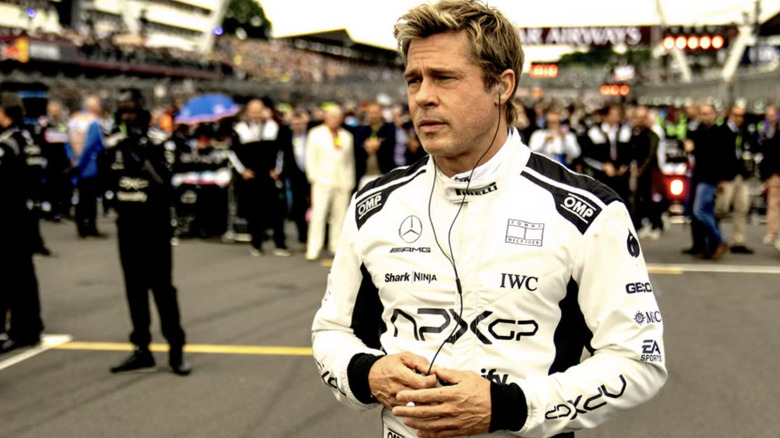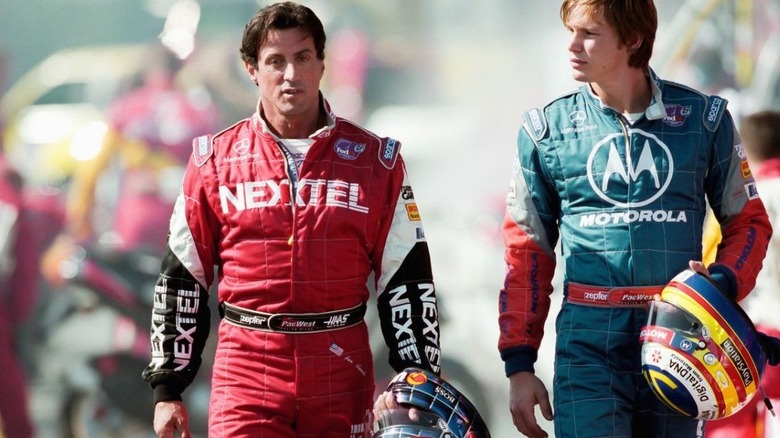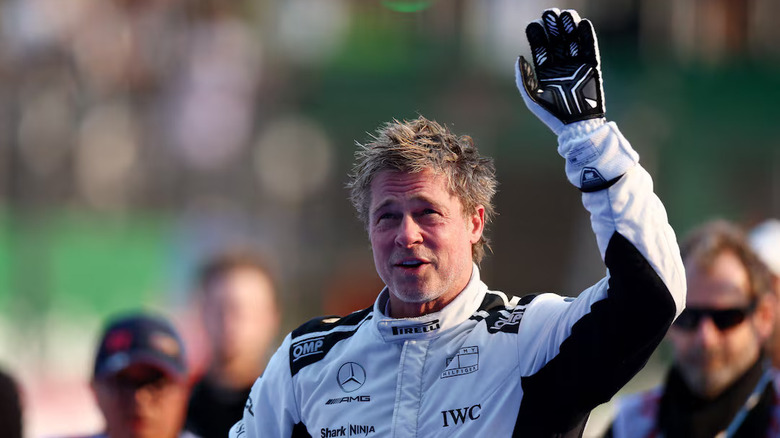Sylvester Stallone Created The 'Rocky Of Racing Movies' Before Brad Pitt's F1
Spoilers ahead for "F1" and "Driven."
Although there are numerous examples of films that helped establish the template for the sports movie, it's 1976 Best Picture winner "Rocky" which coalesced the narrative of a sports film down to a powerfully effective formula. The concept of an underdog, past-his-prime contender fighting his way back to the big time not necessarily to win but just to prove to himself and to others that he can is something that just about every audience member can relate to, whether they're involved in sports or not.
As a result of the massive success of "Rocky" and its sequels, other sports films began to adopt this type of underdog structure, and it's appeared in movies ranging from "The Karate Kid" to "Top Gun" to even, yes, "Happy Gilmore." That's because the core principles of "Rocky" can be applied not just to other types of sports, but to life in general. "Rocky" writer and star Sylvester Stallone himself attempted to apply the "Rocky" formula to — of all things — competitive arm wrestling in the 1987 cheesefest "Over the Top."
Given how much the sport of racing is about endurance and the willpower of the individual over mere strength and skill, it tracks that racing movies would adopt some of that "Rocky" spirit. This month's "F1: The Movie," directed by Joseph Kosinski and written by Ehren Kruger, stars Brad Pitt as Sonny Hayes, a racer who needs to find his mojo for the sport once again in a similar fashion to Rocky Balboa. Using the "Rocky" films as an influence for a movie that dives headfirst into the world of Formula 1 racing would seem like a pretty novel idea. However, it turns out that not only has "F1" been beaten to the punch in this regard, but they were lapped by Rocky Balboa himself (who previously played a racer in one of his very first films). In 2001, Stallone wrote and starred in "Driven," a movie that bears more than a passing resemblance to "F1" in narrative, if not in style.
Driven and F1 feature an underdog embedded in a realistic world of racing
In "Driven," Stallone plays Joe "The Hummer" Tanto, an ex-Champ Car and Indy 500 champion who is lured out of retirement by his old team owner, Carl Henry (Burt Reynolds), in order to mentor Carl's latest Champ Car rookie, James Roman "Jimmy" Bly (Kip Pardue). Jimmy is beset on all sides as he tries to establish himself in the racing world: by his manager brother, Demille (Robert Sean Leonard), by his own self-imposed stress, and by his rivalry with the reigning champion, Beau Brandenburg (Til Schweiger). This latter element gives "Driven" an additional soap opera subplot involving Beau's estranged girlfriend, Sophia (Estella Warren), starting up a flirtation with Jimmy, and it's Stallone's way of nodding to one of the most famous racing rivalries of all time: the feud between James Hunt and Niki Lauda (which was dramatized in Ron Howard's "Rush"). With all of these emotions and hormones flying on and off the track, the more mature Tanto not only has his hands full with mentoring Jimmy, but finds himself starting to get a taste for the sport again, resulting in him becoming a rival to both younger men.
In "F1," Sonny is lured out of retirement by his old racing rival-turned-team owner Ruben (Javier Bardem) in order to mentor his team's hotshot rookie driver, Joshua Pearce (Damson Idris). Where Joe in "Driven" is an underdog in a more classically Stallone fashion, Sonny is part Rocky, part Maverick from "Top Gun" — a daring wildcard who drives his own way, no matter what. Sonny's refusal to play by the book gets under Joshua's skin, while Sonny thinks Joshua isn't trying earnestly enough, and thus a May-December rivalry gets underway. Where "Driven" paints Joe as an underdog due to his being underestimated by everyone around him, "F1" uses Sonny's middle age and his checkered reputation as a continual gambler as the hurdles that he has to overcome.
Both movies vary wildly in their aesthetic — "Driven" director Renny Harlin opts to depict the racing scenes in a very subjective fashion, while Kosinski prides himself on "F1" being as realistic as possible. Yet each film is soaked in the real-life culture of racing, with both movies featuring a series of cameos from various public figures in the racing world.
How F1 passes Driven in its characterization
Despite both "Driven" and "F1" closely resembling each other in their overarching characters and themes, this is less an instance of plagiarism and more a byproduct of the sports movie structure that "Rocky" helped popularize. Saying that the latter ripped off the former holds about as much weight as claiming that every slasher made since 1978 ripped off "Halloween" (even if there's some truth to the notion). It'd be easy to compare "F1" and other racing movies to, well, just about every racing movie ever made. There's as much "Grand Prix" and "Le Mans" in "F1" as there is in "Driven," "Days of Thunder," and so on.
Besides, "Driven" and "F1" end up deviating from each other in their conclusions, demonstrating how their stories and characterizations weren't carbon copies of each other after all. In "Driven," Joe ends up coming in third place behind Beau and Jimmy, which is a very "Rocky"-esque conclusion for his character. The metaphor behind the film paints Joe/Stallone as an aging movie star learning how to cede the spotlight to those coming up behind him, a theme which the actor/writer/director would further explore in his "The Expendables" movies. In "F1," however, Sonny and Joshua not only squash their beef, but come to have a good deal of respect for one another and learn how to work as a team. This allows Sonny to take the win at the end of the movie, proving that Ruben's APXGP team is now a viable contender in F1 and delivering redemption for Sonny, who washed out of the racing world as a young man.
The ending of "F1" further proves that this story wasn't about a competition in order to see who the best man was, but is instead a tale of a man looking to reclaim his reputation while helping his friends in the process. Sonny, having won the championship, decides to bow out of F1 and move on to another challenge, which is racing for a little off-road team in Baja, California. If Joe is the equivalent of a film star understanding that he's not the young leading man anymore, Sonny is the racer equivalent of a knight errant: someone who's in it for the nobility of the quest itself. What's clear is that both characters, just like Rocky, have gone the distance by the end, literally and figuratively.
"F1" is in theaters now.


